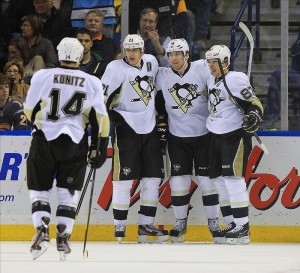If complacency and a loss of focus are primarily to blame for Pittsburgh’s three-goal meltdown at the hands of the Flyers Wednesday, their inability to positively convert on any of their four special teams opportunities is running a close second.

Pittsburgh counted just four shots and no goals on three power play opportunities before Philadelphia earned their first man-advantage time midway through the third period.
They converted on their only chance, and the rest is game one history.
Thursday, the Pittsburgh coaching staff responded by working in a number of new looks on the power play, including splitting up Evgeni Malkin and Sidney Crosby for at least parts of first-team power play sessions.
They’re the two most productive offensive talents in the NHL, but looking at the power play this year, the whole has often been less than the sum of the parts. But is it too late for a new unit to successfully take hold?
New Looks
It’s no secret that the Penguins had a better power play percentage with Sidney Crosby out of the lineup.
Power plays are very much systems. If each player in the group doesn’t know his role in the unit, can’t anticipate who he is passing to before he receives the puck, is unsure when to follow the puck and when to hold position, etc., then the unit is less apt to work.
Much talk has been made of splitting up Crosby and Malkin even before Wednesday’s 0-for-3 showing. The split may have finally happened during Thursday’s practice, in which two “top” units featured Malkin and Crosby as separate go-to guys.
“We want to try and maybe use two units,” defenseman Kris Letang said. “Two sets of players that can go out there and play one minute, get us going.”
“We know the power play needs to be better.”
According to Josh Yohe of the Pittsburgh Tribune-Review, only Malkin, Steve Sullivan and Kris Letang were top-unit locks, with Sullivan and Letang manning the points.
It’s a configuration that worked well during the regular season, but rotating Crosby, James Neal and Chris Kunitz in and out of the first group may be troublesome. Neal was the best shooter on that unit—in all the NHL, for that matter. Neal led the league with 18 power play goals.
The man-advantage has been 17.1 percent effective with Crosby and Malkin both in the lineup, a considerable drop from the 19.7 percent overall success rate.
Game One Futility
It’s no secret what cost Pittsburgh game one. Zero percent success on the power play, 0 percent success on the penalty kill.
When Philadelphia has taken advantage of the Pens this season, the special teams battle has usually tilted in their favor. Four times in six regular season meetings did Philly have a better combined PP/PK percentage than the Penguins, and they won all four. Pittsburgh won the special teams battle in game 82 and in a 6-4 win in Philadelphia in March, scoring once on the power play and twice shorthanded.
Perhaps worse than the final number from last night’s opportunities were the chances Pittsburgh had (or more accurately, didn’t have). The Pens got just 4 shots on goal during 3 power plays, with 11 attempted (7 blocked or missed).
Philadelphia, meanwhile, scored on their only chance, taking only two shots on a power play that lasted 1:42. The Pens cleared their zone once during that kill, meaning Philadelphia spent about a minute and a half inside the zone, setting up shop, waiting for the right shot.
That’s the kind of familiarity with individual roles that makes a power play successful, and its troublesome that Pittsburgh is still tweaking its first group two games into the postseason.
Too Little, Too Late?
Pittsburgh is going to have its hands full. More often than not, these games hit double-digits in terms of combined power play opportunities.
Philadelphia has learned to convert on its chances, giving fits even to a penalty killing group that finished with the best kill percentage in franchise history (87.7 percent).
Pittsburgh has the offensive talent to put forth what should be the most deadly power play in two decades. As they and the Flyers have shown through seven meetings this year, a good system can be far more successful than a superior collection of talent.
And game 84 is not the right time to find a system that works.
Stick-tap to Mike Colligan for discussion and analysis concerning Pens PP.